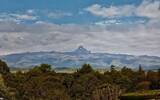Brazil's cold current temperature drops sharply by 14°C! Frost and snow appear in the south!
According to a report by the Brazilian Meteorological Department on August 9, a new wave of cold air has formed in southern Brazil, and the highest temperature in some state capital cities is expected to drop by 14°C in the next few days. This polar cold air has moved southeast. Since Brazil is drier and hotter this year than before, this cold air is the first cold peak to cover all states in the central, western and southeastern regions this year.

Currently, according to data from the National Meteorological Institute of Brazil, temperature changes have appeared in the southern and southwestern states of Mato Grosso and the southern and southeastern states of São Paulo, and have moved to other central and western states, the rest of São Paulo state, Rio de Janeiro state and Miras. The state of Giras is advancing. This cold air will cover most parts of Brazil, and even parts of the north will be affected. Moreover, this cold air will be strong, causing temperatures to drop in most parts of Brazil.
In some states, the temperature drop will be large. For example, in Paraná, the minimum temperature in some areas may drop to 2°C, while in some areas of São Paulo may drop to 6°C, and the temperature in mountainous areas may be even lower. And these states may set records for the lowest temperatures.

In addition, Brazil's National Meteorological Institute warned that a downward trend of frost appears as cold and dry air advances, which increases the possibility of winter rainfall in the south and southeast.
Currently, frost is likely to occur in the central and southern parts of Mato Grosso do Sul in southern Brazil, most areas of São Paulo State, parts of Minas State and mountainous areas of Rio de Janeiro. In addition, local snowfall may occur in the mountainous areas of Rio Grande do Sul and Santa Catarina.
Earlier, Brazil reported that due to drought, production was not expected. Currently, Brazil is worried about the upcoming return of La Niña weather. According to data from the meteorological department, the water temperature in the central and eastern equatorial Pacific continues to drop, and this cooling trend continues to decline. The decline continues for several months, so the La Niña phenomenon has become stronger and will appear as soon as mid-to-late August.
The return of La Niña will intensify severe weather in southeastern Brazil, reduce rainfall and drop temperatures, and the frost situation in Brazil will become more serious. Southeast Brazil is Brazil's main coffee-producing area, so the possibility of falling temperatures and frosts will seriously damage Brazil's coffee production and quality.
Brazil, the world's largest coffee producer and exporter, soared coffee futures prices in Arabica and Robusta after Brazil reported news of a frost. In addition, the International Coffee Organization also released its July coffee report, saying that the coffee price index in July has increased by 48.9% compared with the same period last year. Even though the number of coffee exports increased by 3.8% compared with the same period last year, the price is still high. At present, coffee production in many countries is still not optimistic. Coupled with the impact of the upcoming La Niña phenomenon, prices are likely to rise further.
Important Notice :
前街咖啡 FrontStreet Coffee has moved to new addredd:
FrontStreet Coffee Address: 315,Donghua East Road,GuangZhou
Tel:020 38364473
- Prev

Where are Kenya's coffee producing areas located? What are the characteristics of the western coffee producing area?
Africa is located in the western part of the Eastern Hemisphere and is the second largest continent in the world. The terrain is dominated by plateaus, which accounts for more than 60% of Africa's area and has an average altitude of 750 meters. Africa is rich in natural resources, with many mountains, volcanoes, lakes and rivers, and the land spans the Equator. The climate is mainly tropical, which makes African coffee and other agricultural products.
- Next

What are the characteristics of hand-brewed coffee? Detailed explanation of Rao spin water injection steps! What is the operation of pinching the filter cup for extraction?
As we all know, the brewing process of hand-brewed coffee has always been a very ornamental process, because most water injection methods are soft and soft. The barista will use a gentle technique to inject a highly impactful water for extraction. In this process, the human movements and the impacted powder bed will form a distinctive
Related
- Being chased out of the rain in front of Starbucks?! Store: Sheltering from rain under umbrellas poses a safety hazard
- The white moonlight has changed?! Lucky launches "Big Winter Pear American"
- Hand-brewed coffee three-stage method, high-sweet and universal brewing method to share! What does the high sweet water level of hand-brewed coffee mean?
- What is the difference between raw, refined and full espresso coffee? How to extract espresso and taste good?
- A complete list of coffee bean names and their meanings! What is Yejia Shefi coffee? Where is Mantelin coffee?
- What grade does Arida Manor Kaduai coffee beans belong to? What treatment is Arida ASD slow anaerobic sun exposure?
- The milk tea cup becomes smaller?! Overlord Tea Girl launches a new "Return to Yunnan" series
- Accused of selling counterfeit and high-priced coffee beans! Well-known boutique coffee brand "Oukelao" bowed and apologized!
- How to make espresso dumplings? Can I eat coffee and glutinous rice balls together?
- Save the unformed and stagnant powder cakes in one second! What is the problem with stagnant water in the powder bowl of the espresso machine?

